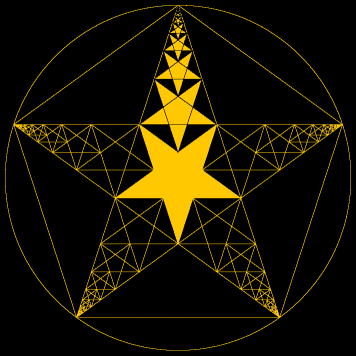Phi-based geometric shapes produce interesting mandala designs.
A mandala is a geometric design, often symbolic of the universe and used in Eastern religions as an aid to meditation.
Phi-based geometric shapes can be used to create some interesting phi mandalas, embodying the phi proportion found throughout creation and iterating into the infinitely large and the infinitely small, much as the universe itself.
Phi Corbett contributed the mandala design below (inspired by Bruce Rawles’ Sacred Geometry Page) which uses the pentagram, also based on phi, to collapse into an infinite series of smaller pentagrams. (Download PDF version)



The Durga Yantra is a well known yantra, and expresses phi using triangles. (see http://bridgetlyonsyoga.files.wordpress.com/2011/09/durga_yantrasm.jpg or just image search durga yantra) The three smallest triangles, usually yellow, are “1” to the “phi” of the next size up (there are six of these, usually a pinkish color). These six are “1” to the “phi” of the next size up, the central triangle. This central triangle is “1” to the “phi” of the next size up, the three triangles that intersect to form the central triangle. (The largest triangle is 2x the size of the central triangle, so not exactly “phi” to anything there. If the circle’s radius is 1, each side of the central triangle is √3/2, I’m sure you can phi-gure the rest out yourself.) Phi-tastic!
Many crop circles remind me of Phi
Thanks for the pdf download of pentagram star. Planning on teaching, so this will be very useful material. Special thanks to Bruce Rawles for his generosity. All the Best!
The word “mandala” has, by this time, made the transition from its literal roots in eastern religion, to become a more generalized English term for any complex pattern, which may not even be religious. I arrived at this section after trying to find a post which I had read some time ago,
It requested information on how Phi may be used in the geometry of the Christian cross. I’m sure that there are several ways that that may be accomplished. However, a few months before reading that post, and even before finding this site, I had constructed a satisfactory arrangement. It’s fairly simple, and amenable to verbal description.
First, you construct two contiguous golden rectangles in portrait position, like quotation marks. Then you construct another identical pair, which overlap the bottom of the first pair, such that the area of overlap is a square. The proportionate cross is formed by the vertical mid-line intersected by the top of the square. This construction provides two golden rectangles (landscape) above the cross-bar, and two (portrait) below.
The standard construction method for golden rectangles is used throughout.